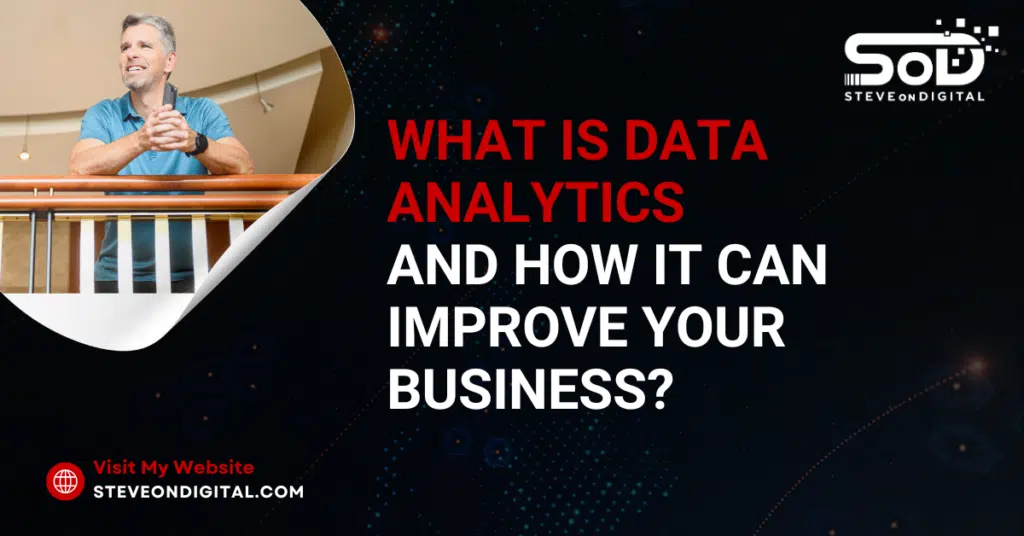What Is Data Analytics And How It Can Improve Your Business? | SOD

In today’s fast-paced and technology-driven world, data analytics stands as a cornerstone of modern business. As Steve Johnston, owner and author of SteveOnDigital, I’ve witnessed firsthand the transformative power of data analytics across various sectors. Data analytics involves examining raw data to glean insights that inform business decisions, enhancing efficiency and profitability. Business intelligence plays a critical role in this landscape, providing the necessary tools and frameworks to understand vast amounts of data effectively. Core Concepts: Data Analytics, Business Intelligence, And Customer Data Data analytics is not just a buzzword but a fundamental component of strategic decision making in many businesses today, including small and medium-sized enterprises (SMEs). By integrating data analytics, business intelligence, and insights derived from customer data, companies can unlock new opportunities and gain a competitive edge. From optimizing supply chains to tailoring marketing strategies, the impact of data analytics is profound and far-reaching. Understanding The Data Analytics Process From Data Collection To Data Analysis The data analytics process starts with collecting raw data, which can range from sales figures and customer interactions to market trends and beyond. This raw data is often voluminous and unstructured, making it challenging to process. However, with the right tools and techniques, such as data science and machine learning, this data is transformed into structured, analyzable sets. Once structured, the process of analyzing data begins, using statistical tools and algorithms to identify patterns, trends, and relationships. Exploring Data Types In my experience, understanding the difference between unstructured data and structured data is crucial. Unstructured data, such as emails, videos, and social media posts, is formless and not easily sorted through traditional data models. On the other hand, structured data is organized and easily searchable, often stored in relational databases. Effective data analytics requires tools that can handle both types, integrating them into a coherent analysis that supports business intelligence. Role Of Data Analysis In Business Strategy Leveraging Historical And Sales Data For Strategic Planning Analyzing historical data and sales data allows business leaders to not only assess past performance but also to forecast future trends and prepare accordingly. For instance, by examining historical sales data, businesses can predict customer demand, optimize stock levels, and even adjust pricing strategies to maximize profits. This predictive analytics approach is something I often discuss on my platforms like YouTube and LinkedIn, illustrating its importance with real-life examples from SMEs. Real-World Success One compelling case study involves a retail client who leveraged data analytics to revamp their inventory management system. By analyzing customer data and sales data, they could better predict which products would be in high demand. This not only reduced overstock and understock situations but also enhanced customer satisfaction as popular items were always in stock. Another example is a service provider who used customer feedback and data analysis to refine their service offerings, significantly increasing customer retention and satisfaction. In both examples, the businesses utilized data analytics to not only understand their current market position but also to anticipate market trends and adapt their strategies accordingly. As someone deeply embedded in the digital transformation space, I’ve advised numerous companies on similar strategies, ensuring they harness the full potential of their data to drive business success. How Data Analytics Enhances Customer Understanding Analyzing Customer Behaviors And Trends Understanding customer behavior is pivotal in today’s business environment. As the head of SteveOnDigital, I have consistently leveraged data analytics to delve deep into customer trends and behaviors. This approach is essential because it allows businesses to understand what motivates customer actions, preferences, and buying patterns. By analyzing customer data and observing how these trends evolve, businesses can tailor their products and marketing strategies to meet the precise needs of their consumer base, leading to increased customer satisfaction and loyalty. Enhancing Customer Experiences Through Data Insights One effective technique for analyzing customer interactions involves the use of sophisticated data analytics tools that track and record every touchpoint a customer has with your business. This might include website visits, social media interactions, and direct communications. By employing data science and machine learning algorithms, we can extract actionable insights from this data, helping to refine customer service approaches, personalize communication, and ultimately enhance the overall customer experience. For instance, through my digital platform, we’ve implemented chatbots that analyze incoming customer queries to provide instant, relevant responses that are tailored to individual needs, significantly improving user satisfaction. Predictive Analytics And Identifying Market Trends Forecasting The Future With Predictive Analytics Predictive analytics is a form of advanced analytics that uses historical data along with machine learning and statistical algorithms to predict future outcomes. In my role at SteveOnDigital, I’ve used predictive analytics to anticipate customer demand and spot emerging market trends before they become apparent. This capability is crucial for adjusting business strategies dynamically and ensuring competitive advantage. For example, by analyzing historical sales data and customer behavior patterns, we can forecast which products will see increased demand, allowing for better stock management and marketing focus. Staying Ahead Of Market Changes Through Predictive Models The main benefit of predictive modeling is its ability to provide business leaders with foresight, rather than just insight. This forward-looking approach not only helps in anticipating changes in the market but also in preparing more robustly for potential disruptions. Predictive models can identify trends that inform product development, marketing strategies, and even risk management practices, helping businesses stay one step ahead of competitors and align more closely with customer expectations and needs. Metric Before Predictive Analytics After Predictive Analytics Improvement Forecast Accuracy 70% 90% 20% increase Customer Demand Prediction 65% 88% 23% increase Market Trend Identification 60% 85% 25% increase Using Data To Streamline Operations And Reduce Costs Optimizing Business Operations With Data Analytics Data analytics is instrumental in streamlining operations within a company. By analyzing data from various business operations, companies can identify inefficiencies and areas for improvement. For example, in my experience, by analyzing workflow and production data, we have been able to optimize processes to reduce waste and increase throughput. Moreover, data

